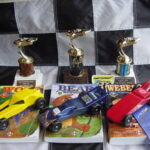It’s Pinewood Derby time in Cub Scout packs across America. When designing your Pinewood Derby car for maximum speed, weight placement can mean the difference between returning home with a trophy and just returning home. Here are some tips on Pinewood Derby car weight placement for maximum speed.
Pinewood Derby Car Maximum Weight
Five ounces. That’s the magic weight. The closer you can get to five ounces, the faster your Pinewood Derby car should fly down the track.
To get your Pinewood Derby car as close to five ounces as possible be sure to weigh the car at various points during the design phase.
Once you’ve cut out your car, weigh it to get its base weight. Then place the wheels and axles on top of the car (you won’t be attaching them to your Pinewood Derby racer just yet) to see just how much weight you will need to add. Then add weights to the car until you reach approximately five ounces. Remember that paint adds a negligible amount of weight as well, especially if you use several coats.
If you are going to be drilling out sections of the car to add weights, remember that you are removing wood in the process and will need more weight to make up for the loss in wood. Also remember that if you are going to use spackle or wood putty to seal in the weights, that also adds weight to the car. Be sure to take into account that as these compounds dry, they lose some of their weight as well.
Be aware that the official scale used on race day may differ from yours. Be prepared to add weight at weigh in (or take weight away). Be sure to bring a portable drill to remove excess weight if need be, and extra weights and glue if your car should be too light.
Now that you have an idea of how much weight your Pinewood Derby car will need to reach five ounces, let’s look at where your weight should go.
Pinewood Derby Car Weight Placement
Pinewood Derby cars are driven by one thing – gravity, or more specifically, potential energy due to gravity. While we won’t get into the complicated physics of potential energy, a simplified formula works well for Pinewood Derby cars.
Potential energy = mass x acceleration due to gravity x height
The greater potential energy, the faster your car will go. The acceleration due to gravity is a constant for all the cars, so we don’t need to worry about that. This leaves two factors you can do something about – mass (i.e. weight) and height.
The differences are ever so slight, but a car with the greatest amount of weight placed toward the rear should have slightly more potential energy than if the weights are placed in front. This varies depending on the angle of the Pinewood Derby track, but even the difference of a couple inches may give your car a speed advantage at the bottom end of the track. Also notice that the car’s maximum weight affects the amount of potential energy as well. With five ounces as the maximum Pinewood Derby car weight, the closer you get to five ounces the more potential energy your car will have.
Place as much of your car’s weight as possible as far back and as high up as you can.
Too Much of a Good Thing
While you want to have the weights placed in the rear, too much weight behind the rear axle may cause your Pinewood Derby car’s front end to raise up off the track. This could cause the car to fly off the track, damage or disqualify your car, so be careful just how much weight your place behind the rear axle. To avoid this, try to make sure your car’s center of gravity is slightly in front of the rear axle.
You can easily find your car’s center of gravity using a round pencil as a fulcrum. Elevate the pencil on a level surface so that the car’s wheels are lifted off the surface. Then, place the car across the pencil. Adjust the car to see where it is balanced. Ideally the pencil should be just in front of the rear axle when your Pinewood Derby Car can balance on its own.
If your car’s center of gravity is behind the rear axle, try placing some weight on the other side to shift the center of gravity forward. Remember to still try to keep this extra weight as far back as possible.
This may seem like a lot of trouble to go through to build a Pinewood Derby car, but the last race my Cub Scout participated in, my son’s car finished in second place. Not bad considering our car weighed in at 4.75 ounces. My son didn’t want to add any more weight because he liked the way the car looked and didn’t want to stick an “ugly” weight on it. The only car to beat my son’s car was the pack champion. In the three heats these cars competed in head to head, my son’s car was slower by a combined total of 4 one thousandths of a second. That’s .004 seconds total between the first and second place Pinewood Derby trophies.
So remember, for maximum speed your Pinewood Derby Car should weigh 5 ounces and have its weights placed as far back as possible. A little bit of weight makes a big difference at the finish line.
To see a collection of free, easy Pinewood Derby car design ideas and picture links, click HERE.
For more tips on how to build a winning Pinewood Derby car, click HERE.



